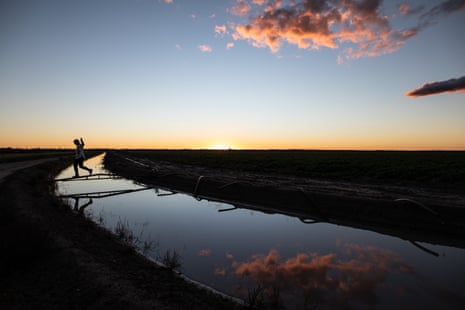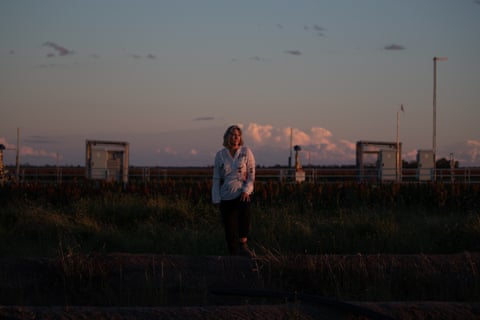The black soil sinks and then swells around Zena Ronnfeldt’s boots as she steps through rows of cotton on her property near Dalby in Queensland’s Darling Downs. “The soil is just so great, we can grow a dozen different crops here,” Ronnfeldt says.
“We have mung beans and chickpeas, cotton, corn, wheat, barley, and silage for feedlots. If we needed to, we could grow vegetables under irrigation. It’s just a food bowl.”
In recent years, pockmarks have spread like a rash across the landscape. Satellite images show how development of the coal seam gas industry has accelerated, as thousands of wells have been built across some of Australia’s most productive farmland.
The conflict between these competing multibillion-dollar industries – agriculture and onshore natural gas – has bubbled here for more than a decade.
A timelapse of satellite imagery shows the rapid rise in gas wells in the region west of Dalby.
But what Ronnfeldt discovered beneath the black soil on her property last year has brought the strained relationships between some landholders and gas companies to a critical point – a deteriorating situation that has farmers and resources law experts demanding an immediate pause to the ongoing gas ramp-up.
During the process involved in sinking a new water bore, Ronnfeldt learned that Arrow Energy – a joint venture between global petroleum giants Shell and PetroChina – had drilled diagonally underneath her land.
“Years ago they did mention the fact that they might want to put wells on our property, and I talked to them about the size of the compensation bill. We never heard from them again,” Ronnfeldt says.
“They were drilling on the property next door and when we asked, Arrow wouldn’t say where the wells were going.”

The Queensland government is formally investigating allegations that Arrow commenced “deviated” drilling beneath multiple properties without providing a formal entry notice or otherwise notifying landholders. Arrow has admitted “mistakes” as it developed dozens of these deviated wells, but has previously said it “genuinely did not believe entry notices were required”.
The investigation has dragged on for 10 months without result. Arrow continues to drill deviated wells but is now notifying landholders.
Now the company is expanding gas operations to new parts of the Darling Downs, east of the Condamine River, sparking warnings to farmers to seek legal advice before signing any agreements.
Ronnfeldt says subsidence (an anticipated effect of CSG extraction) has occurred on a section of her property since the drilling started.
“We’ve got a field over the back now, that’s 120 hectares that we’re struggling to crop at all,” she says.
“It’s all about the drainage. It’s like in your street and your city and garden, when it gets waterlogged and doesn’t get away. We’ll be slopping around in mud or the machinery gets bogged.
“We actually have damage and the company is making no real commitment to any sort of rectification at all. They treat us with such disrespect.”
In response to Ronnfeldt, Arrow said any “ground movement due to CSG has not occurred to the extent it has altered the drainage on the property”.
The Queensland Department of Environment and Science told Ronnfeldt they could not investigate the subsidence because Arrow’s state environmental approval “does not specifically contemplate or regulate broad-scale subsidence” and that damage to the commercial productivity of farmland is not considered “environmental harm”.
Bubbling discontent turns volatile
Across the Darling Downs (the gas companies call roughly the same area by its geological name, the Surat basin) there is emerging evidence that CSG operations will leave a significant physical legacy on the landscape.
Russell Bennie’s family has owned land in the Cecil Plains area since the turn of the 20th century; they’ve been growing broadacre crops here for about 70 years.
“Over the past four to five years we’ve been noticing staining on the ground, it happens after rainfall typically,” Bennie says.
“It basically has a rainbowy sheen to it, and it’s getting worse. We’re about 3km from a gasfield that has been active for 15 years.”


Last year, Bennie took some soil scrapings and had them tested. The lab confirmed the presence of volatile organic compounds – or hydrocarbons – in the soil.
The testing does not establish the source of the hydrocarbons. There are some places in the region where gas seepage – such as the bubbling Condamine River, famously set on fire by the Greens MP Jeremy Buckingham – are considered to be a natural phenomenon.
There is also evidence – detailed in a report commissioned by the Queensland government last year – that gas escape in the Condamine is “enhanced” by nearby CSG production.
“[The soil staining] is something we’ve never seen, and we’ve been operating continuously for 120 years,” Bennie says.
Most often, attention on the impact of gas fracking, mining or development focuses on the potential environmental harm caused by these activities.
But under Queensland law, agricultural land has no environmental value. Any damage to the black soil plains used by farmers would not be subject to environmental regulations; instead it becomes a much more complicated matter to resolve.
There are expected physical impacts from CSG on farmland. Queensland government reports expect water volume in 702 water bores in the Surat basin will be affected by the impact of gas drilling in the long term. That figure keeps rising, from 459 in 2016 and 571 in 2019.
Gas drilling is also expected to cause subsidence of more than 15cm in some areas. That distance might seem insignificant until you see some of the Darling Downs farmland: the countryside is unerringly flat, expanding in some directions to an ocean-like horizon.
‘Why can’t I just say I don’t want this?’
In Australia, property rights are complicated by a regime where resource companies and landowners have overlapping tenures. The inevitable conflicts between the gas and agricultural sector are governed by complex laws and regulations, which in Queensland have developed in a piecemeal way as issues arise.
The state has never had an inquiry like the Victorian process that resulted in a ban on fracking to protect agriculture.
Madeline Taylor, one of a handful of lawyers in Australia whose work focuses on the intersection of resources and agriculture, says the cumulative impacts of the gas industry in Queensland “are still not understood”.
“Now we’ve had the CSG industry in Queensland for over a decade, we are only now seeing the real human effects, the social licence impacts, the erosion of community trust,” Taylor says.


BOTTOM: Arrow gas pipeline construction in Kupunn. Photograph: David Kelly/The Guardian
“We need to now take a precautionary approach. Those cumulative impacts will play out over a matter of decades. It’s time to halt development, to do a proper scientific inquiry, rather than constant amendments to legislation and regulations, which create constant uncertainty for landholders.
“The protection of our best arable land is crucial in Australia because we don’t have much of it. We’re the most arid continent in the world. We’re seeing constant climate change effects and we will have diminishing agricultural productivity in this country.”
In that context, Arrow Energy’s deviated wells – some which begin on one property, but drill underneath another – have become significant.
“For the first time we’re really seeing pressure on our property law framework in Australia, because of deviated wells,” Taylor says.
“It has shone a light on the limits of property rights for landholders. What I constantly get is farmers asking me: ‘Why can’t I just say I don’t want this?’”
If there is no significant surface impact, Queensland law classifies directional drilling as a “preliminary activity”, generally allowing companies to drill under private land without a prior agreement in place. Regulations generally require them to notify the land-holder before starting.
Guardian Australia sought an interview with a representative from Arrow, but the company declined.
In response to questions, a spokesman said the company was “committed to working with (landholders) in good faith to address their concerns.
“Our goal remains to build and maintain long-term positive landholder relationships based on openness, trust and mutual respect. If landholders have concerns, we encourage them to contact us or the regulators directly.”
In earlier statements, the company has admitted unspecified “mistakes” during the early implementation of its “deviated wells model”, which it says was designed to minimise ground disturbance by allowing several slanted wells to be drilled from a single site.
“Arrow appreciates that our Surat activities are taking place on some of the state’s most productive black soil, and that we must take exceptional care to minimise our impacts on landholders, communities and the environment to deliver our project.”
Last month, the Gasfields Commission, an agency set up to promote “coexistence” between farmers and the gas industry, called on the government to urgently finalise its investigation to provide clarity.
A 2020 Queensland government audit of how the CSG sector was generally managed by government raised serious questions about the state’s compliance regime.
“At present, no one is providing transparency and certainty that regulators of the CSG industry are performing their roles effectively,” it said.
Last year the Environmental Defenders Office compiled a similar report detailing failings of a regulatory system weighted heavily in favour of gas companies.
It found that environmental assessments for gas projects were often minimal – in some cases allowing projects to double in size without any additional assessment – and that the legislation supposed to protect priority agricultural land, the Regional Planning Interests Act, was not effective.
“No application for a regional interest development approval has ever been refused, and concern exists that conditions placed on these approvals are often minimal,” the EDO report found.
Digging in for the long term
When Arrow announced its plans to expand east of the Condamine River, a group of agricultural peak bodies – Cotton Australia, the Queensland Farmers’ Federation, AgForce and Central Downs Irrigators Limited – issued a joint statement urging landholders to seek legal advice before signing agreements.
“[On] February 17, a number of agricultural representative organisations were advised by Arrow Energy that it had issued its deviated well agreement to a small number of landholders, and two had signed,” they said.

A few months ago, a representative from Arrow turned up at Bev and Wayne Newton’s property at Kuppun, west of the town of Dalby.
The company said that they would soon begin drilling diagonally underneath their property, from a well pad built near the boundary.
“They shoved a map in our hand saying … [they were] drilling these,” Bev Newton said.
“They’re being drilled parallel to huge water storage we’ve got, they want to run deviated wells parallel to the banks of our 1,000 megalitre ring tank wall. Who, then, is held responsible for a health and safety issue?”
Arrow has since paused drilling plans relating to the Newton’s property.
Bev says the CSG companies have adopted a “divide and conquer” approach in the years they have been operating in the Downs. Some farmers welcomed gas companies onto their land and signed compensation agreements to host wells. Others objected, but ultimately signed when told that attempting to block access could require costly court action.
One landowner who does have a compensation agreement with Arrow, who did not want to be named because of the depth of feeling within the local community, said compensation agreements had provided “a little” income during recent years of drought.
Bev Newton says: “If I had a block out west, I’d gladly welcome them too.
“It’s not that we’re opposed to gas, but it’s a fossil fuel and it’s on the phase-out.
“We have our children who have gone away to study and come back and they want to look after the land. We want to look after it for them. Agriculture will be here long after the gas wells are gone.”
